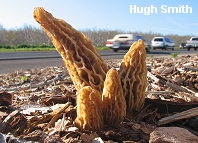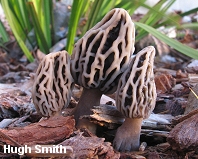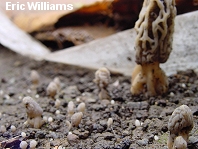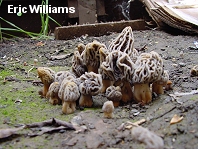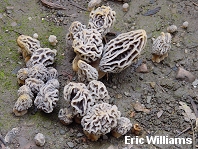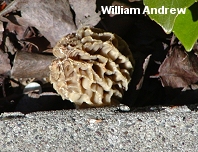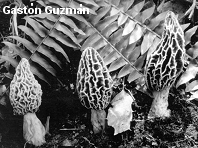| Major Groups > True Morels & Verpas > Morchella rufobrunnea |

|
Morchella rufobrunnea [ Ascomycetes > Pezizales > Morchellaceae > Morchella . . . ] by Michael Kuo This distinctive morel was originally described from Vera Cruz, Mexico, where mycologists Gastón Guzmán and Fidel Tapia collected it along a road bed. They noticed several distinctive features for the mushroom, including the fact that its surfaces bruised reddish brown to reddish orange--so they named the species "rufobrunnea" to reflect the interesting color change. One of the first interesting results from DNA testing of morels sent in to the now closed Morel Data Collection Project was the fact that several collections from landscaping sites along the West Coast matched Morchella rufobrunnea. Over the years the result was repeated many times, making it clear that the species is quite common in coastal California and Oregon, appearing in winter and early spring in gardens, planters, woodchip beds, along road sides, and so on. Unlike many of the genetically distinct morel species that DNA testing has revealed, Morchella rufobrunnea is also morphologically distinct--meaning it has observable features that separate it from other species of morels. When young its cap is often distinctively twisted and pointed, and it has dark pits and nearly white ridges. By maturity the pits and ridges are more or less yellowish. The most distinctive feature, however, is the salmon pink to orangish or rusty brown bruising. Morchella rufobrunnea is the proper name for the "Morchella deliciosa" described by many western American authors (e.g. Arora, 1986). In addition, DNA testing (see O'Donnell and collaborators, 2011) reveals that commercially cultivated morels also correspond to Morchella rufobrunnea. This is not particularly surprising, since Morchella rufobrunnea is one of the very few saprobic morel species and is therefore one of the few that could be successfully cultivated--and since R. Ower, who patented the morel cultivation process (1985), originally worked with a collection he made in a San Francisco planter. What were the odds? Had Ower been virtually anywhere else in North America, the morels he picked could not have been cultivated, and his patent would never have been developed. I have studied one collection of Morchella rufobrunnea from central Michigan, where the species appeared in an urban garden in October; it appears to represent an escape from a nearby facility where morels are commercially cultivated. From an evolutionary standpoint Morchella rufobrunnea is particularly interesting since it is, as the DNA people say, "basal" to the entire tree of true morels. In other words the species is a bit like crocodiles, since it has been around, essentially unchanged, since the Cretaceous period. All of the morel species we know today, according to O'Donnell and collaborators (2011), evolved from something like Morchella rufobrunnea. Description: Ecology: Clearly saprobic when growing in tree-less environments, but perhaps potentially mycorrhizal in other locations; apparently limited to disturbed ground in North America; originally recorded from the Gulf Coast of Mexico on a road bed; found with frequency in winter and early spring in coastal California and Oregon landscaping sites, usually in the year following the disturbance to the ground. Cap: 6-12 cm tall and 2-5 cm wide; conical or nearly so, especially in youth, but occasionally egg-shaped or nearly round; pitted and ridged, with the pits primarily arranged vertically, at least when young; when young with bluntly rounded to flattened, nearly white ridges and dark brown to black pits; when mature with sharpened or eroded, yellowish to brownish yellow pits and ridges; bruising salmon to orangish or reddish brown; completely attached to the stem; hollow. Stem: 2-9 cm high and 1-2.5 cm wide; more or less equal, but sometimes swollen at the base; whitish to grayish, yellowish, or brownish; bruising orangish to rusty or reddish brown; bald or finely mealy with granules; hollow. Spore Print: Pale orange or yellowish orange. Microscopic Features: Spores 19-25.5 x 12-17 µ; smooth; elliptical; without oil droplets; contents homogeneous. Asci 8-spored. Paraphyses cylindric with rounded to subclavate or subcapitate apices; septate; hyaline in KOH. Elements on sterile ridges 75-125 x 7-15 µ; septate; hyaline to brownish in KOH; terminal cell clavate, widely fusoid, or more or less cylindric with a rounded to subacute apex. REFERENCES: Guzmán & Tapia, 1998. (Arora, 1986 ["M. deliciosa"]; Guzmán & Tapia, 1998; Kuo, 2005; Kuo, 2008; O'Donnell et al., 2011; Kuo et al., 2012.) SPECIMENS EXAMINED: Herb. F. 06059601 (isotype), 03180301, 03300302, 03180401, 12110401, 03060501, 03080501, 03270501, 03290501, 03110601, 10160601. Herb. Kuo 02200901. This site contains no information about the edibility or toxicity of mushrooms. |
© MushroomExpert.Com |
|
Cite this page as: Kuo, M. (2012, October). Morchella rufobrunnea. Retrieved from the MushroomExpert.Com Web site: http://www.mushroomexpert.com/morchella_rufobrunnea.html. |
